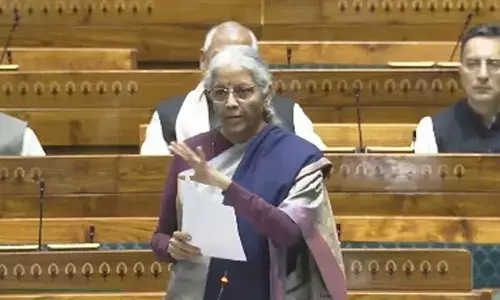Power crisis a priority to retain power

The new state of Telangana to be formed on June 2 will face immediate power shortage to the tune of 3,000 MW but the power shortage could scale up to 11,000 MW with increase in demand.
The new state of Telangana to be formed on June 2 will face immediate power shortage to the tune of 3,000 MW but the power shortage could scale up to 11,000 MW with increase in demand. As most of the power plants are located in the residuary state of Andhra Pradesh, the new state needs to take immediate steps to fill the gap between demand and supply.
There have been contrast arguments about series of mammoth lift irrigation schemes taken up under Jalayagnam about a decade ago but many people started realizing that they are economically unviable and financially disastrous projects. Apart from cost escalations not to complete in specified time period, other main reason is, these projects require over 8,600 MW of installed capacity to generate electricity needed to operate their massive pumps and motors to lift the water.
Particularly in Telangana projects like Pranahita-Chevella, Dummugudem, Yellampally, Kanthalapally require huge capital expenditure and quantity of power and it will be a huge challenge before the new state. to complete these projects. Particularly, Pranahita-Chevella lift irrigation scheme is ill conceived because it requires 3,466 MW power to lift water up to Chevella. It was just meant to take the Telangana people for a ride. This and other lift irrigation projects are conceived just to benefit contractors, particularly from Seemandhra region.
There is a lot of talk about using Godavari water in Telangana but it is flowing three to four metre below the land level in Telangana and all the proposed projects under construction are lift irrigation schemes requiring huge quantity of power. The cost of Pranahita project cost is Rs 40,000 crore according to 2011-12 estimates and proposed to be completed byn 2018. The Andhra Pradesh government has already spent Rs 3,000 crore on this project. It is certainly going to be a problem to government in new Telangana state in completing the project. Similarly, the cost of Kanthalapally project in Warangal district is estimated at R 23,000 crore and it needs 1,000 MW power. The cost of Devadulla project in Khammam district is estimated at Rs 10,000 crore. The Andhra Pradesh government has spent Rs 6,500 crore on this project.
Pranahita-Chevella will account for world's longest canal (both open and closed portions counted) travelling for a stretch of 1,055 km from the barrage across the Pranahita where water is tapped, up to Chevella near Hyderabad, its terminating point. It includes 849 km of open canal, 206 km of tunnels and the remaining pipelines. The water will be pumped up to a height of over 2,000 ft in stages through 22 lifts (each with a pump-house and motors) located at different points to take it to Chevella.

As of 2014-15estimates, the costs may go up to 70,000 crore and the cost may further go up considerably by the time project is completed. As of now, it involves a capital expenditure of Rs.4,75,000 an acre. The Government has to spend Rs.30,000 per acre every year on the maintenance and operation of the lift irrigation system, not to mention the cultivation costs to be incurred by the farmer. The operation of the lift irrigation system calls for generation of nearly 4000 mw of power. How can anyone justify expenditure of such a magnitude when the farmer does not get more than Rs.20000 an acre?
As of now, the State is allocating nearly 70 million (7 crore) units a day to the agriculture sector out of the total 240 million units generated every day. In addition the state is now committing 8000 Mw of power for unviable lift irrigation schemes. The new lift irrigation projects alone will require allocation of an additional 120 to 150 million (12 to 15 crore) units a day. Is it possible in a power-starved State?
The Government has already given away to contractors Rs.1100 crore on the unviable project even without a sod of earth being turned up merely to reward contractors and earn commissions.
Instead of spending money on Pranahita chevella and other unviable projects, it should be utilized to improve groundwater table, soil fertility, to build infrastructure, promote industrialization and generate employment in Telangana. Otherwise, the project will turn out to be a burden round the neck of new Telangana State. The lift irrigation projects proposed under Jalayagnam in the Telangana would require a total of 6000 MW of additional power and, all such projects need a thorough review.
Present Power situation
Currently, the entire state has an installed capacity of 16,350 MW of which 10,500 MW falls in the Seemandhra region and 5,850 MW is in the Telangana region. Also, the fact that about 10 lakh of the total 16 lakh agricultural pump sets that currently get free power are located in the Telangana region which are contributors to Transmission and Distribution losses, will be a huge challenge to meet.
Considering the existing shortage in the region and with the demand expected to grow at 10 to 12 per cent, the existing capacity addition plans for the region are very meager. Currently, only Bhopalpally Stage II, which is 600 MW, is expected in 2013-15 and another 600 MW thermal power plant by Singareni, is expected after two years.
Of the 5,850 MW i.e nearly 60 percent installed capacity that Telangana region has over 2,400 MW is hydel and is largely dependent on the monsoons which is available only when reservoirs receive good inflows. This brings down the overall effective capacity to roughly 4,000 MW. At current market rates, energy imports may cost Rs 10,000 to Rs 16,000 crore each year.
To address the power shortage in the Telangana region after the division of Andhra Pradesh, the Central Government has proposed setting up of a 4000 mw ultra mega power project by NTPC. The power sector giant will take up the development of the plant for Telangana once it secures coal linkages. With concerted efforts, the coal requirement could be part-met from the State-owned coal mining company Singareni Collieries Company Limited supplemented by other sources. However, securing coal by imports or other means increase cost of power generation considerably.
One must realize that the shortage of coal supply from the Singareni Collieries Company Limited (SCCL) following the incessant rains during the monsoon season and the frequent tripping of power stations had forced the National Thermal Power Corporation (NTPC), Ramagundam, lag behind in power generation during this financial year of 2013-14. Against the target of generating 15,286 million units of power till January 1, 2014 (during the nine months period of the financial year), the NTPC could generate only 14,410 million units.
The new Telangana state inevitably face serious power crises and it is time that party coming to power prepare a comprehensive plan to overcome prevailed crises in power shortage. Some suggestions to address the problem are as below;
• New Telangana state must immediately complete ongoing 600 MW Bhoopalpanny plant by end of the year. It must plan to generative additional 600 MW using coal from Singareni Colleries onl
• Major power in Telangana is going to be used for agricultural pump sets which is used freely by farmers.. Hence focus should be on using solar power by extending subsidy up to 80 to 85 percent like in Rajasthan and Gujarat. This will be cheaper than huge irrigation projects and avoid recurring costs to state exchequer.
• Try to get 2000 MW plant exclusively to Telangana like it was given to Simhachalam plant to AP few years ago.
Unless the party coming to power addresses the issue as priority it will be difficult to retain power in the long run.
Next Story














